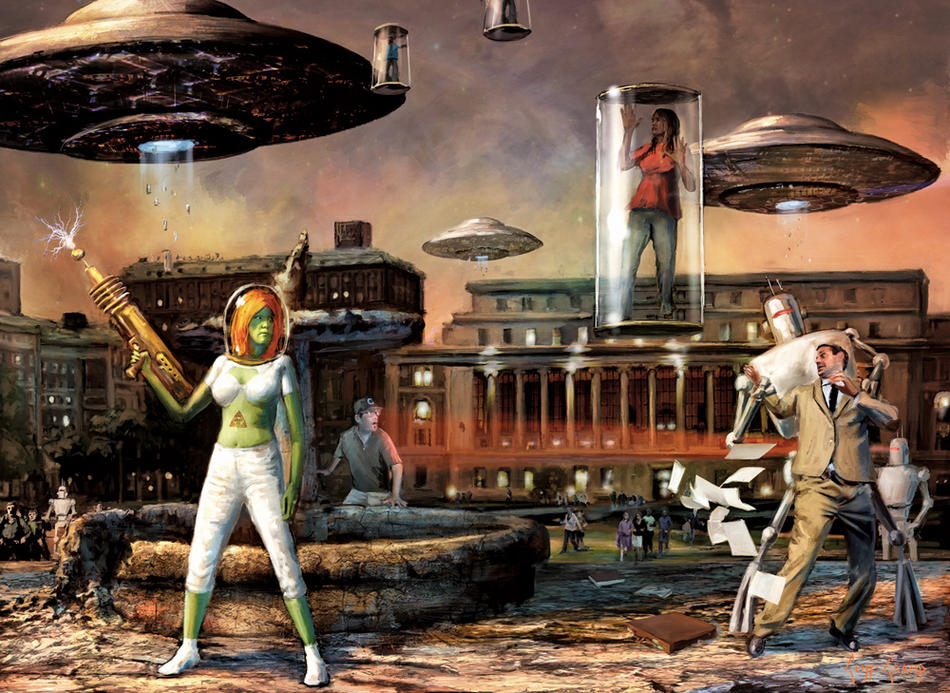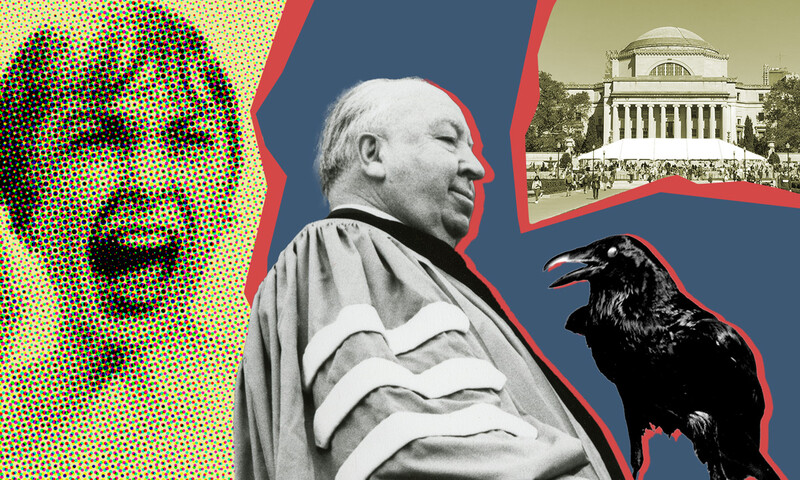In stack level 1, in the bowels of Butler, graphic-novel librarian Karen Green ’97GSAS rips open a box of magazines that await classification and binding. She pulls out a November 1989 issue of Amazing Stories, with a cover illustration of a dour Albert Einstein clutching his fiddle while an anonymous galaxy hovers in the background. “Awesome!” she says.
Green dips into the box again, extracting another issue, this one with short fiction by Ray Bradbury, Harlan Ellison and Samuel R. Delany, Theodore Sturgeon and Richard Matheson. “November 1968,” she murmurs, glancing at the jet-packed, space-suited astronaut hovering at the bottom of the cover. “That’s the month I turned ten.”
Even beyond the marquee names of Isaac Asimov ’39GS, ’41GSAS and Robert Silverberg ’56CC, Columbia can claim its share of figures in science fiction and fantasy. Among them are anthologist Groff Conklin ’27CC; writer Roger Zelazny ’62GSAS; book editor Liz Gorinsky ’03CC; and publisher Ian Ballantine ’38CC, who with his wife, Betty, founded Ballantine Books, which became a leading science-fiction publisher in the 1950s. This summer, Betty Ballantine donated a trove of books and papers to the Rare Book and Manuscript Library.
The magazines that Green is now processing were donated in July by Fred Lerner ’66CC, ’81LS — a collection of two thousand or so copies of such titles as the Magazine of Fantasy & Science Fiction, Astounding Science Fiction, and, of course, Amazing Stories. Lerner, as an undergraduate, had founded the Columbia University Science Fantasy Society (CUSFS), which in the 1970s morphed into today’s Columbia University Science Fiction Society, with an identical acronym affectionately pronounced “cuss-fuss.”
“In my high school, almost no one I knew read science fiction,” says fantasy author Pauline J. Alama ’86BC. “Meeting the people in the club was like meeting the people of my tribe.”
Since its inception, CUSFS has hosted mini-conventions; produced a newsletter of reviews, essays, and fiction called CUSFuSsing (with that peculiar capitalization); screened movies like Metropolis and Blade Runner; held birthday parties for hobbit extraordinaire Bilbo Baggins; and conducted virgin sacrifices to Cthulhu, a creation of H. P. Lovecraft (“It typically involved wrestling in a pool filled with fake blood,” recalls former CUSFS president Eugene Myers ’00CC).
At the heart of CUSFS is its lending library, which once comprised some thirteen thousand books and magazines and still includes such noncirculating treasures as a signed copy of Asimov’s Second Foundation and an 1887 edition of Jules Verne’s Twenty Thousand Leagues Under the Sea. Acquisitions have always been eagerly sought; in January 1979, CUSFS took a road trip to the Alexandria, Virginia, home of George Leonard ’39CC, ’41LAW to pick up 1,500 books and magazines for deposit in their headquarters in Ferris Booth Hall.
But the library became a casualty when Lerner Hall replaced Booth in 1999. In the new student center, CUSFS was shoehorned into a shared room with the Philolexian Society and could not house all its volumes, approximately 75 percent of which were consigned to storage. Attempts to donate some of the excess volumes to Butler failed. “There was no interest,” says former CUSFS president Noah Fulmor ’99CC, “because they said they had rarer volumes that they had no room for.” After being stashed in various places on and near campus for years, the overage was sold and donated, with the last three thousand volumes going to the Housing Works Bookstore Cafe this summer. “
Any student library is going to have a problem because it will have turnover and will be run on the honor system — which often doesn’t work well,” says Lerner, who is an information scientist at the Vermont headquarters of the National Center for Posttraumatic Stress Disorder. “My take is that a student science-fiction library shouldn’t seek to be a definitive collection but rather a recreational resource.”
Meanwhile, volumes on robots, aliens, and intergalactic space travel that might once have ended up with CUSFS continue to flow into Butler. Lerner has sent eighteen boxes so far, he says, with “much more to go.”
It was Karen Green, Columbia’s librarian for ancient and medieval history and religion, who laid the groundwork for Lerner’s haul. In 2005, Green parlayed her interest in comics into an additional role as Butler’s first graphic-novel librarian. The new collection signaled that the University was receptive to nonconventional literary genres and formats.
Green sees Butler’s role for science fiction primarily as one of preservation. Calling science fiction an ideal medium “in which to process society’s fears and anxieties,” she harks back to Ray Bradbury’s dystopian masterpiece Fahrenheit 451, in which books have been outlawed and citizens endlessly watch interactive floor-to-ceiling TVs.
“Many things Bradbury described are now part of the landscape,” she says. “As a librarian, I’m seeing less print and more electronic journals. But we’re doing what we can.”



